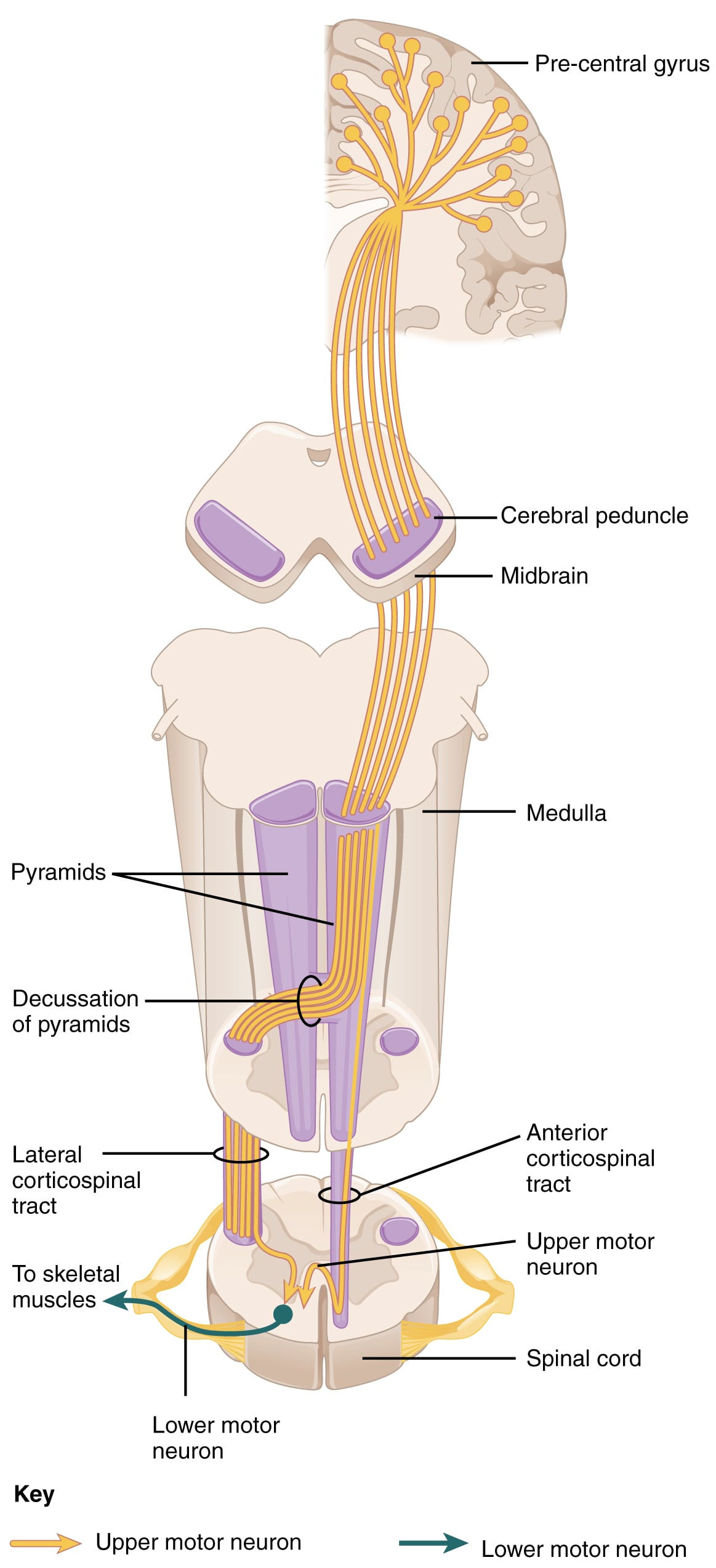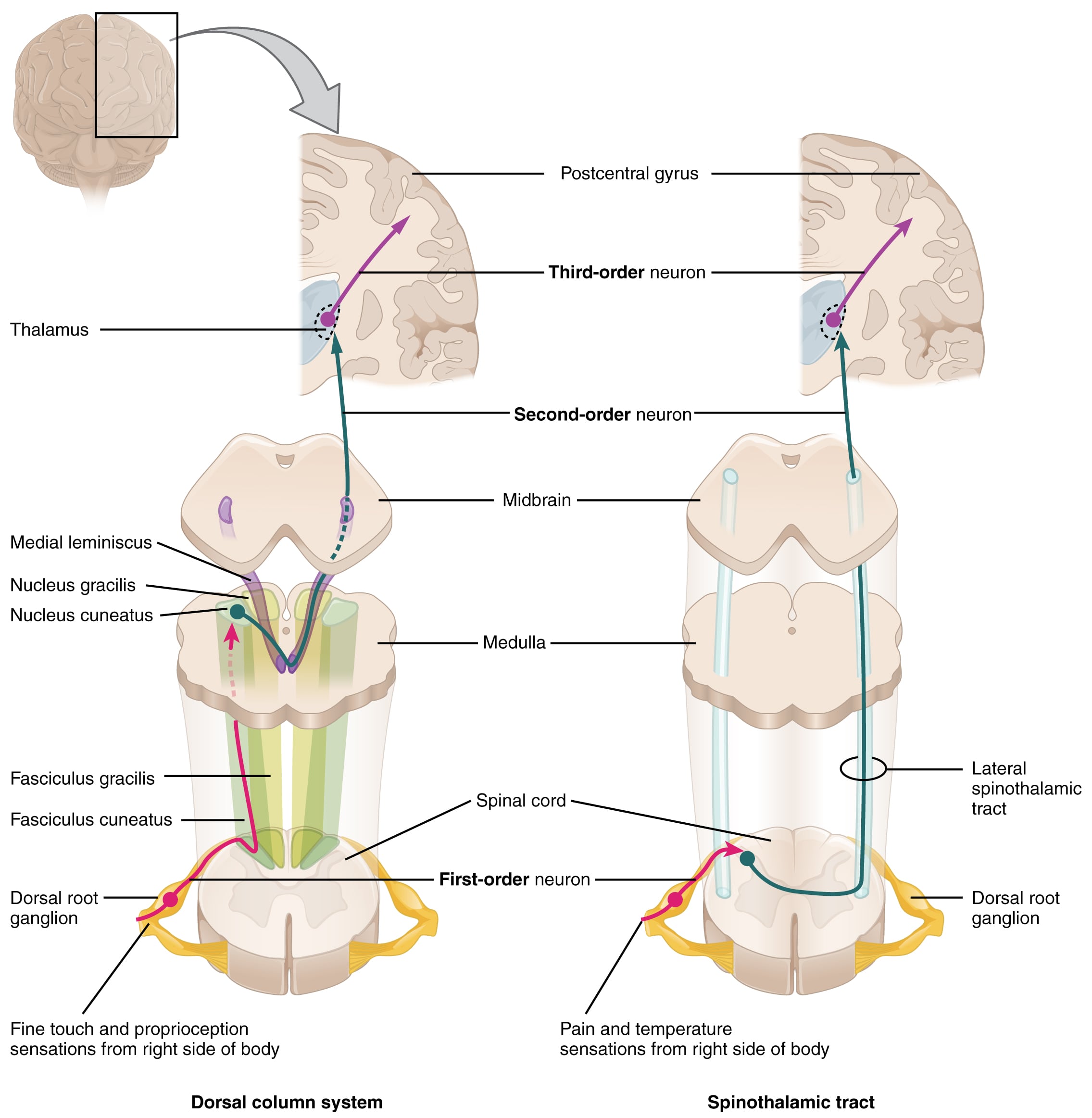It is a descending tract arising mostly from the primary motor and premotor cortex (Brodman areas 4 and 6). Some fibres arise from the primary and secondary somatosensory areas. They form the internal capsule and descend ventrally in the midbrain, pons, and medulla. Once it reaches the lower medulla, about 85 to 90% of the fibers will cross over or “decussate” at the pyramidal decussation to form the lateral corticospinal tract. They continue their descent in the lateral funiculus and terminate at all spinal cord levels. At the pyramidal decussation, 10 to 15% of fibers that did not decussate will continue down uncrossed as the anterior corticospinal tract. These fibers control proximal muscles such as those in the trunk. Lesions above the decussation will cause symptoms on the contralateral side of the body, whereas lesions below the decussation (typically the spinal cord) will cause symptoms on the ipsilateral side. The primary purpose of the corticospinal tract is for voluntary motor control of the body and limbs.

Rubrospinal tract arises from the red nucleus of the midbrain and is associated with voluntary muscle movements of the flexor muscles of the upper limb. Lateral reticulospinal tract arises from reticular formation in the medulla and inhibits spinal motor neurons. Medial reticulospinal tract arises from the pontine reticular formation and activates posture related extensor muscles. The vestibulospinal tract activates posture related extensor muscles.
Lissauer’s tract is a pathway formed from the proximal end of small unmyelinated and poorly myelinated fibers in peripheral nerves, which enter at the lateral aspect of the dorsal horn and ascend and descend up to four segments. They terminate in laminae I through VI of the ipsilateral dorsal horn. These axons mostly carry crude touch and pressure information. These fibers are intimately related to the substantia gelatinosa.
This sensory tract carries sensations of pain, temperature, crude touch, pressure, and nociception. It is divided into anterior and lateral spinothalamic tracts. The anterior spinothalamic tract carries sensory input about crude touch. The lateral spinothalamic tract carries information about pain and temperature. The first-order neuron is a pseudounipolar neuron located in the dorsal root ganglion. The efferents from the nucleus travel in the Lissauer’s tract and synapse with second-order neurons in the substantia gelatinosa, which is located in the grey matter of the spinal cord. Efferents from second-order neurons cross over to the opposite side, in the anterior commissure, two segments above the level of entry ( remember this for the clinical presentation of syringomyelia ). They then ascend anterolaterally in the spinal cord and enter the brainstem as the spinal lemniscus. The spinothalamic tract of the anterolateral system terminates in the ventral posterolateral nucleus (VPL) of the thalamus, the third-order neurons of this pathway. From there it ascends through the posterior limb of the internal capsule to terminate in the primary somatosensory area. Topographically, cervical areas are represented medially, while sacral area is represented laterally.

This ascending tract carries sensations of fine touch, two-point discrimination, proprioception, and vibration. It is also called the dorsal column-medial lemniscus pathway. The first-order neuron is located in the dorsal root ganglion. It receives afferents from Meissner’s corpuscles, free nerve endings on hair follicles, Pacinian corpuscle, muscle spindles, and Golgi tendons. The efferents from first-order neurons enter the spinal cord medially in the dorsal root. The tract will then ascend as the fasciculus gracilis and cuneatus. The fasciculus gracilis, which is located medially, carries sensations from the lower extremities and terminates in the nucleus gracilis in the caudal medulla. Fasciculus cuneatus, on the other hand, is located laterally and carries sensations from the upper limbs, finally ending in the nucleus cuneatus in the caudal medulla. The second order nuclei (nuclei gracilis and cuneatus), will give rise to the internal arcuate fibres which will cross to the contralateral side in the medulla. These crossed fibres will then ascend as the medial lemniscus. It terminates in the ventral posterolateral nucleus (VPL) of the thalamus, which comprises third-order neurons. Finally, the axons from VPL will ascend in the posterior limb of the internal capsule and end in the primary somatosensory area in the post-central gyrus of the brain.
The dorsal and ventral spinocerebellar tracts carry unconscious proprioception information from muscles and joints of the lower extremity to the cerebellum. The spino-olivary tract carries information from the Golgi tendon organs to the cerebellum.
Note: There are many important spinal cord lesions.
The spinal cord and its associated spinal nerves are supplied by a single anterior spinal artery and 2 posterior spinal arteries. The anterior spinal artery supplies the anterior two-thirds of the cord. The posterior spinal arteries supply the dorsal columns. All three spinal arteries arise from the vertebral arteries in the skull. Segmental branches of the thoracic and abdominal aorta have radicular branches that anastomose with the spinal arteries to provide additional blood supply to the spinal arteries. One of the largest radicular branches, the great radicular artery or artery of Adamkiewicz, supplies the anterior spinal artery. Lack of flow to this vessel can cause ischemia to the spinal cord. It is important to avoid damaging this artery in thoracic, abdominal, and retroperitoneal surgical procedures. Damage may lead to anterior spinal syndrome manifesting as paralysis below the level of lesion, loss of pain and temperature at and below the level of lesion, hypotension, erectile dysfunction, and urinary and fecal incontinence.
Sign up for free to take 11 quiz questions on this topic